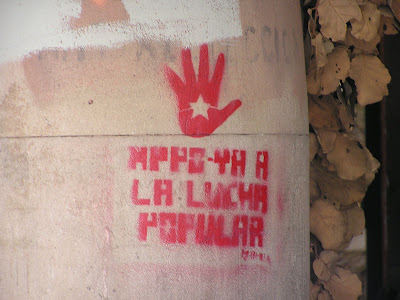
There's a lot going on in Oaxaca this summer. Beneath the city's peaceful veneer the people are tense with unresolved fallout from last year's teachers' strike. (For background on the teachers' strike and people's uprising of 2006, see here and here.) Political graffiti mars buildings along the Alcala, a historic street paved with cobblestones and closed off from regular local traffic. "Presos Politicos Libertad!", Free Political Prisoners!, and "Vive La APPO" are two popular slogans repeated in red or blue paint on the faces of buildings and street signs. "Vive La APPO"--referring to the powerful group (Oaxaca People's Assembly, in English) that emerged out of the populist movement last summer--is scrawled in white paint across the windows of Scotiabank, a Canadian bank prominent in Mexico. The graffiti we see today is not leftover from last summer, but fresh in the past couple weeks. Those who were here last summer describe a paint war between activists and the government. The entire city was covered in political graffiti. New slogans went up every day, and every night the police whitewashed whole city blocks. While that battle has slowed, these new markings are evidence of a resistance that does not plan to go quietly away. Indeed, new tags appear daily since we arrived. Messages are painted on businesses and homes in the neighborhoods around the zocalo, the central square. Much of the content is the work of activists, though some only represents the efforts of rambunctious youth. In some cases it can be hard to tell the difference.
We had dinner tonight with Jenna's former Spanish teacher, a native Oaxacan, and her American husband who has lived in the country for seven years. When I asked about the political tone in the city, and if things were back to normal, the table went slightly tense. They both exchanged a glance and Adam, who is naturally outspoken, said, "We'll see."
Tourism appears to be thriving here, and the vendors who sell to turistas have not been deterred by last year's troubles. (Perhaps this is disingenuous; many here have little choice how they'll earn a living.) Cafes line three sides of the zocalo and maintain a steady business catering to Mexicans on holiday and foreign travelers alike. On sidestreets leading to the zocalo tourists browse expensive artwork in the high-end galleries that can afford the rent at the heart of the city. To judge by these storefronts of clean, bright new paint and sleek wooden doorways, well-lit signs and fancy window displays, Oaxaca City could be mistaken for an opulent retreat tucked away in the rugged mountains and high desert. Get a couple blocks south of the central square, however, and you'll find a different picture of Oaxaca. Narrow, crowded sidewalks give way to tightly packed storefronts on busy streets where vendors sell everything from watches to hardware to tacos to jewelry in an effort to simply stay afloat. In these neighborhoods and commercial districts outside the city center it becomes obvious that there is an uneven distribution of wealth in the city. Moving beyond these neighborhoods and into the public markets, stalls of produce, meats, clothing and trinkets literally overwhelm the senses. There is so much variety and yet so much repetition; you get an even clearer idea how difficult it is for many here to make a living.
Talking to Oaxacans about the strike, and about whether business has recovered, there is a consensus that neither tourism nor activism have returned to normal levels. In other words, tourism is still down and activism up. There is talk of boycotting this year's Guelaguetza, scheduled on consecutive Mondays for July 23 and 30. The Guelaguetza is the major cultural event of the year, a massive festival that celebrates the traditional values of sharing and cooperation cherished by Oaxacan Indians. Indeed, walking through the zocalo yesterday Jenna and I encountered a tent sponsored by APPO and Section XXII, the teachers' union, where activists handed out flyers advertising the boycott and spoke with anybody interested about the problems still facing the people of Oaxaca under Governor Ulises Ruiz Ortiz. [Update: Today there are more tents set up, reminiscent of last year's protests. Activists play videotaped footage of the people's demonstrations last summer and the violence that broke out when state police attempted to remove protestors from the square. DVDs of the protests and violence are on sale, ostensibly to raise money for APPO and Section XXII, though I may be naive to make the assumption. Family and friends of political prisoners are on hand at the zocalo, advertising on large banners the plight of loved ones locked away. Banners calling for the removal of Governor Ruiz from office have also become more numerous and more prominent in recent days.]

As we toured language schools last week and spoke with Oaxacan Spanish teachers, there was a general understanding that nothing is yet known. "Vamos a ver," they said. We will see. This year could still be very difficult in Oaxaca City. If the boycott is successful and the Guelaguetza is not held in the Cerro del Fortin, the large amphitheater on the northwest side of the city, then government will suffer a setback. The director of one of the schools we visited pointed out that the money raised from the Guelaguetza does not benefit the Oaxacan people. Tourist tickets for the Guelaguetza are on sale at the local TicketMaster outlet for $38 US. He does not know where that money goes, but suspects the profits line the pockets of those who already have money: big businesses, promoters and politicians. This is hardly in keeping with the spirit of the event. In the meantime the governor has promised that the festival will go on as scheduled. This likely means that an army of state police, paramilitaries--armed men sympathetic to the PRI, the governor's political party--and perhaps even federal troops will descend on Oaxaca City for the last two weeks of July, as Oaxacans from other parts of the state converge on the city in an annual journey for the celebration--or for protests.
According to our friends here many US newspapers did not do justice to the strife in Oaxaca last summer. The government targeted teachers and activists, broadcast their names on the radio, and intimidated, menaced and arrested those who spoke out against political corruption and the unfair distribution of wealth in the state. By some accounts the government tortured and disappeared people. Political prisoners remain in custody today.* Many protestors who were picked up by government troops in the final raids to reclaim the city were immediately flown to prisons on far sides of the state, out of reach of their family and friends. Police helicopters circled the city, shining lights down on protesters, on vehicles and into homes. Activists set out roadblocks throughout the city at night with whatever they had, buses, automobiles, furniture, old appliances or bricks, to keep state vehicles from following people into the neighborhoods. Drive-by shootings occurred in what appeared to be assassinations of political targets. To those who were here, Oaxaca City in October and November of 2006 felt like a city at war.
The course of this summer has yet to be determined. As I posted earlier, the Mexican Supreme Court is investigating accusations of human rights violations that may have occurred during last summer's events. Governor Ruiz has not been to Oaxaca City since the events of last summer. Mexican President Felipe Calderon, who was soundly defeated across the state of Oaxaca in last year's national election--despite widespread suspicion of vote tampering--has not been to Oaxaca City since he took office on December 1, 2006. It is unclear whether APPO and Section XXII are planning demonstrations similar to those staged here last year. There are rumblings that the government is preparing for a fight. The next couple of weeks may tell us a quite a lot about what is in store for Oaxaca in the near future.
*I have been unable to verify this figure.
CORRECTIONS: The governor has been to Oaxaca City as recently as June. See here. Thanks to Zoe for passing that on. Going through my pictures last night showed me that the slogan painted on the window of Scotiabank actually says "Presos Politico Libertad," not "Vive La APPO" as I state in paragraph 1.

Tags: Oaxaca, Ulises Ruiz Ortiz, APPO, Section XXII, Teachers' Strike, Guelaguetza 2007


